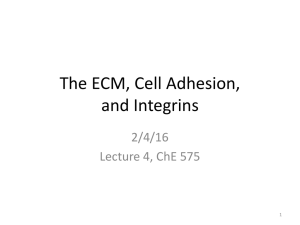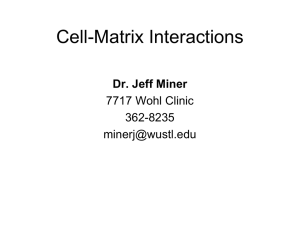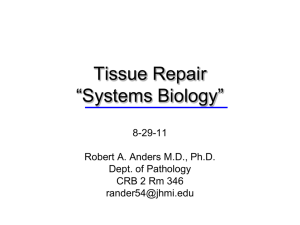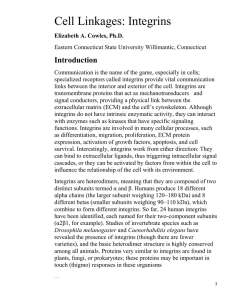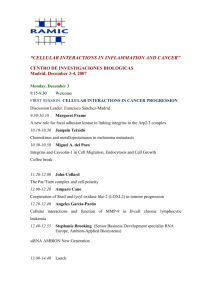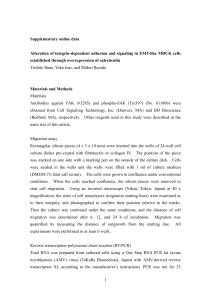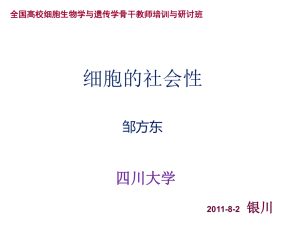Integrin annoted bibliopgrahy - Biol512
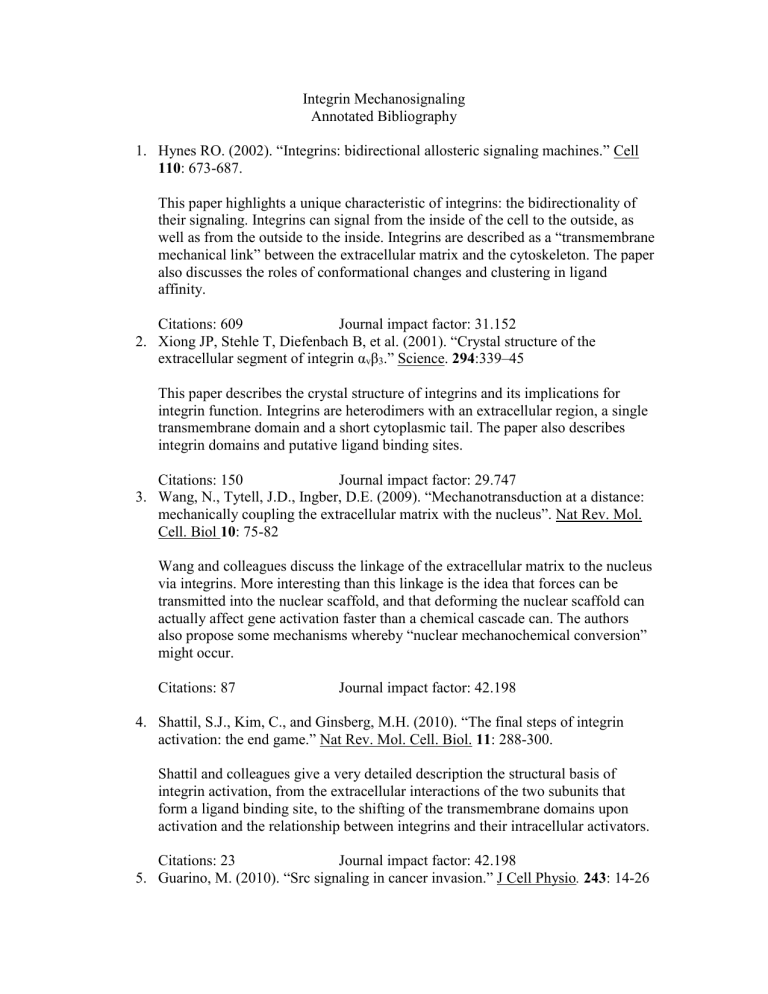
Integrin Mechanosignaling
Annotated Bibliography
1.
Hynes RO. (2002). “Integrins: bidirectional allosteric signaling machines.” Cell
110 : 673-687.
This paper highlights a unique characteristic of integrins: the bidirectionality of their signaling. Integrins can signal from the inside of the cell to the outside, as well as from the outside to the inside. Integrins are described as a “transmembrane mechanical link” between the extracellular matrix and the cytoskeleton. The paper also discusses the roles of conformational changes and clustering in ligand affinity.
Citations: 609 Journal impact factor: 31.152
2.
Xiong JP, Stehle T, Diefenbach B, et al. (2001). “Crystal structure of the extracellular segment of integrin α v
β
3
.” Science. 294 :339–45
This paper describes the crystal structure of integrins and its implications for integrin function. Integrins are heterodimers with an extracellular region, a single transmembrane domain and a short cytoplasmic tail. The paper also describes integrin domains and putative ligand binding sites.
Citations: 150 Journal impact factor: 29.747
3.
Wang, N., Tytell, J.D., Ingber, D.E. (2009). “Mechanotransduction at a distance: mechanically coupling the extracellular matrix with the nucleus”. Nat Rev. Mol.
Cell. Biol 10 : 75-82
Wang and colleagues discuss the linkage of the extracellular matrix to the nucleus via integrins. More interesting than this linkage is the idea that forces can be transmitted into the nuclear scaffold, and that deforming the nuclear scaffold can actually affect gene activation faster than a chemical cascade can. The authors also propose some mechanisms whereby “nuclear mechanochemical conversion” might occur.
Citations: 87 Journal impact factor: 42.198
4.
Shattil, S.J., Kim, C., and Ginsberg, M.H. (2010). “The final steps of integrin activation: the end game.” Nat Rev. Mol. Cell. Biol.
11 : 288-300.
Shattil and colleagues give a very detailed description the structural basis of integrin activation, from the extracellular interactions of the two subunits that form a ligand binding site, to the shifting of the transmembrane domains upon activation and the relationship between integrins and their intracellular activators.
Citations: 23 Journal impact factor: 42.198
5.
Guarino, M. (2010). “Src signaling in cancer invasion.” J Cell Physio
. 243 : 14-26
The paper summarizes the signaling role of Src in cell adhesion formation, protrusion, turnover and disassembly. It contains a diagram depicting the role of
Src not only in adhesion, but proliferation and angiogenesis, as well. It also provides a detailed description of many of the players in these pathways.
Citations: 10 Journal impact factor: 4.586
6.
Huveneers, S., and Danen, E.H. (2009). “Adhesion signaling – crosstalk between integrins Src and Rho.” J Cell Sci.
122 : 1059-1069
Huveneers and Danen detail the signaling that occurs during early cell spreading and late cell spreading. This signaling involves the activation of FAK and Src during integrin adhesion, and the role of the FAK-Src complex . They then discuss the crosstalk in mechanotransduction and physiological processes, such as hemostais and bone resorption.
Citations: 50 Journal impact factor: 6.14
7.
Baker, E.L., and Zaman, M.H., “The biomechanical integrin.” J Biomech. 2010
January 5; 43(1): 38
This paper reviews the biomechanical role of integrin and refers to the large body of knowledge on integrins. Integrins stabilize tissue structure, bear stress and transmit force, facilitate cell migration via FAK and Src, influence important cellular processes (such as motility), contribute to cardiovascular diseases, and facilitate cancer progression. The paper is good mostly for locating other references.
Citations: 5 Journal impact factor: 2.657
8.
Caswell, P.T., Vadrevu, S., and Norman, J.C. (2009). “Integrins: Masters and slaves of endocytic transport.” Nat Rev. Mol. Cell. Biol. 10 : 843-853
Caswell and colleagues review integrin trafficking by the endosomal pathway and how this trafficking can actually influence their function. Depending on the type of integrin, integrins can be endocytosed by clathrin-dependent and clathrinindependent mechanisms. It is thought that the internalization and recycling of integrins can serve to localize the activity of Rac, causing spatially-restricted, brief zones of actin polymerization. This paper also discusses the role of integrins in controlling the trafficking of other receptors, hence the title of the article.
Citations: 31 Journal impact factor: 42.198
9.
Moore, S.W. Roca-Cusachs, P., Sheetz, M.P. (2010). “Stretch Proteins on
Stretchy Substrates: The important elements of integrin-medicated rigidity sensing.” Dev Cell.
19 : 194-206
This paper focuses on the rigidity-sensing of integrins. It outlines the parameters that determine what rigidities can be sensed through integrins, as well as the actual strength of some integrin bonds to the extracellular matrix at the molecular level. Along with these are lists of the methods by which these bonds and forces are measured. Most interesting and detailed of all is the rigidity sensing cycle, which details the mechanisms of rigidity sensing.
Citations: 5 Journal impact factor: 13.363
10.
Moser, M., Legate, K.R., Zent, R., Fassler, R. (2009). “The tail of integrins, talin, and kindlins.” Science. 324 : 895-899
Moser and colleagues devote this paper to the discussion of inside-out signaling and how intracellular components (such as talins and kindlins) interact with integrins to cause conformational changes and changes in integrin affinity to extracellular ligands.
Citations: 65 Journal impact factor: 29.747
11.
Qin, J., Vinogradova, O., and Plow E.F. “Integrin bidirectional signaling: A
Molecular View.” PLoS Biol. 2004 June; 2(6): e169
This paper briefly reviews the molecular basis of inside-out signaling and clustering. The binding of talin ultimately causes an integrin to have increased affinity to an extracellular ligand, which can cause integrins to cluster if the ligand is multivalent.
Citations: 38 Journal impact factor: 12.916
12.
Puklin-Faucher, E., & Sheetz, M.P. (2009). “The mechanical integrin cycle.” J
Cell Sci. 122 : 179-186.
This paper summarizes the bidirectionality of integrin signaling and examines the activation of integrins as a cycle that begins with cell-extracellular matrix adhesion. The cycle then continques with the linkage of integrins to the actin cytoskeleton via adaptor proteins like talin, then the pulling of a cell past adhesion sites, and finally the turnover of integirins
Citations: 46 Journal impact factor: 6.14
13.
Shattil, S.J., and Newman, P.J. (2004). “Integrins: dynamic scaffolds for adhesion and signaling in platelets.”
Blood. 104: 1606-1615.
Shattil and colleagues discuss the role of αIIβ3 integrins in platelet aggregation via clustering. αIIβ3 integrins are the platelet fibrinogen receptor, and are of particular interest as clinical targets for arterial thrombosis. They also detail the
biochemical basis of αIIβ3 integrin signaling, specifically outside-in signaling— its regulation, initiation and propagation.
Citations: 188 Journal impact factor: 10.555
14.
Assoian, R.K., Klein E.A. (2008). “Growth control by intracellular tension and extracellular stiffness.” Trends Cell Biol . 18(7) : 347-352
This paper discusses the relationship between integrins Cyclin-D1 expression and the Rho pathway. The ECM may actually play a role in regulating cyclin D1 in endothelial cells. Rho activity might activate cyclin D1 expression by regulating
ERK activity, which is dependent on integrins. All of this is may provide information on how tension can affect cellular proliferation.
Citations: 32 Journal impact factor: 12.115
15.
Schedin & Keely (2010). “Mammary Gland ECM Remodeling, Stiffness and mechanosignaling in normal development and tumor progressio.” Cold Spring
Harbor Perspectives in Biology .
This paper is broad in the sense that it does not focus on integrins, but rather mechanosignaling in mammary cells and how the stiffness of the extracellular matrix is related to tumor proliferation. Most interesting are the different biomechanical sensors that the authors propose are involved in the sensing of stiffness, including integrins and talins.
Citations: 1 Journal impact factor: ?
